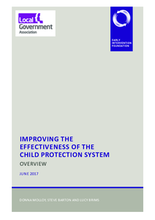Executive summary
Increasing demands on the child protection system in the context of current fiscal constraints has led to growing debate as to how scarce resources can be used to best effect. This project, a collaboration between EIF, the LGA and the NSPCC, with support from Research in Practice (RiP) and the Department of Social Policy and Intervention at the University of Oxford, addresses three main questions:
- What has been shown to improve outcomes for children in the child protection system?
- What do we know about what local areas are delivering as part of the child protection system?
- What do we know about the overall effectiveness of the child protection system?
This overview report provides a summary of key findings and lessons from five detailed research papers, which have been published separately.
What does the evidence tell us about what is effective in improving outcomes for children in the child protection system?
The review of evidence published as part of this project has identified interventions that have been shown through robust studies to be effective in improving outcomes for vulnerable children.
Where families are facing complex, multi-layered problems, an integrated package of support is almost certainly required. The evidence points to the value of parentfocused interventions that are underpinned by clear logic models (theories of change) geared to strengthening parent–child interactions and reducing child conduct problems. The components of this package must be identified following assessment of the needs of the family, and interventions must be targeted specifically according to these needs and the age of the children.
The success of any intervention depends on a number of common elements, the most important of these being the quality of the therapeutic relationship between a practitioner and the child, parent or family. The evidence suggests that strengthsbased approaches which acknowledge the challenges parents face are likely to be more effective than overly focusing on parental deficits, which is more likely to lead to resistance.
The review of evidence published alongside this report highlights the specific interventions and practices with proven evidence of effectiveness in detail, and is summarised in this overview report. This evidence provides an important new resource for local authorities.
This report is an overview of five strand reports as part of a collaborative project with NSPCC, Research in Practice, the University of Oxford, and the University of Edinburgh.
- Strand 1: Improving the effectiveness of the Child Protection System - A review of the literature
- Strand 2: Child protection - a review of the literature on current systems and practice
- Strand 3: The use of research evidence regarding 'what works' in local authority child protection systems and practice: An analysis of five local authorities
- Strand 4: Trends in Child Protection: England
- Strand 5: An analysis of international trend data on child protection indicators
To read more about this project, please visit the Early Intervention Foundation website by clicking here.

